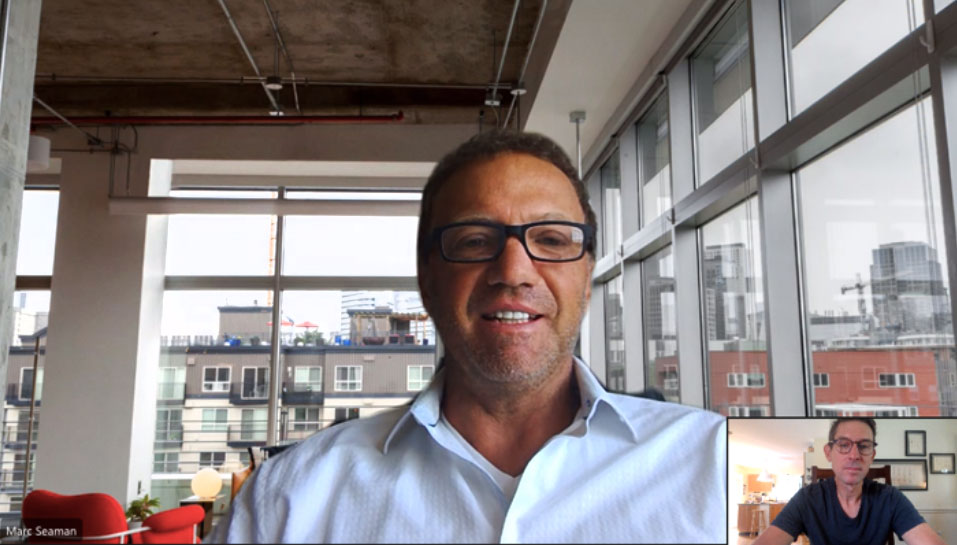Since Marc Seaman started as the lead of the Microsoft education team 8 years ago, a lot has changed, particularly in the past year in response to the demands of the pandemic. But even before that, he wanted to shift the focus away from things—devices, IT, infrastructure—and toward people, learning, and student success. I reached him at his home in Ottawa, via Teams, to ask about his role, how educator feedback has changed some key aspects of the Microsoft offering, and what it’s like to meet Bill Gates.

Glen Herbert
Editor/Writer, Our Kids Media

How has the relationship between Microsoft and schools changed in the years that you've been with them?
I think that, where we were seven or eight years ago versus where we are now, it’s really been a journey. At one point we were selling technology, whereas now we are working with educators in creating inclusive learning environments for students. That's become the key focus. So our relationship with educators has become less of just a vendor to them and more of a partner in designing classrooms, designing tools that have the student at the centre. And that’s changed everything, from how we license our products—as you know, Office 365 is free for pretty well every student and educator across the country—to how we've approached our professional development.
That’s something that grew exponentially through the experience of the pandemic—that professional development piece—I guess most obviously through the webinars and the workshops.
Yeah, you know, just last year we trained over 120,000 educators. Now that’s a pretty significant number for us. And that changed our relationship with the educator community because it enabled us to be part of the conversation, helping them learn how they can leverage technology to enable student-centric learning. We know that learning starts with great teachers, and that a successful student will be an engaged student, and an engaged student will have a great teacher. But [we also know it] will have personalized learning tools that are enabling them to be engaged, ensuring that every student can learn in their own style.
We've been living at that mission statement for a long time—"empowering every student and educator to achieve more”—but over the last few years we’ve really evolved that. It’s really become a joint relationship with educators based on how they can leverage technology as part of their teaching and to have that student experience at the core. That's probably been the biggest evolution, to be honest with you: moving on from product design and engineering right through to that relationship with the educator.
“There’s no lack of great teachers, just as there’s no lack of great technology, but it’s how those two are enabled together. … the investment has already been made, and now it’s learning how you can balance and leverage that investment.”
What do you feel the optimal relationship looks like between Microsoft and individual schools?
I think there's a few components, but I would say that, at the core is how we think about that Kindergarten-through-career journey. How we think about the stages [of learning] as well as the skilling component. Our goal is to not just have students have great learning experiences, but to have experiences that lead them toward having a strong transition to either higher ed or to the workplace.
I think most of our institutions and boards across the country have an existing relationship with Microsoft. In fact I believe it's close to 100% are fully licensed for the Microsoft suite. So, you know, there's a strong relationship there. But we have focused the last number of years, again, on that professional development piece. Having educators on our team, working with the educator community--what we call our global training partners--to build that relationship beyond just IT and infrastructure. Working with educators closely around how they can leverage the tools they already own. To do the hands-on sort of one-to-one and one-to-many training to really help schools learn how to leverage the technology that they've already invested in.
In your experience, what are schools looking for in a technology partner?
I think they are looking for affordable technology, first and foremost. Accessible technology, so that every student has again that opportunity to access personalised learning. But I think they're also looking for a partnership. There's no lack of great teachers and there's no lack of great technology, so it's about how those two are enabled together … the investment [in technology] has already been made, and now it’s learning how you can balance and leverage that investment.
Innovation, without a doubt, has long been a hallmark of the Microsoft brand. Where has innovation been happening on the education side of things?
I think where we've seen some great advances in the STEM side and how some of the teachers have been able to use the maker spaces to create some real touchpoints for students. Gamification has become such a big important part, and it speaks to so many students; they're doing coding while not even recognizing it.
That's one aspect of innovation that I think is really important. Also, where we've gone with Teams. Building the platform, making more than just a meeting space, but becoming a full collaboration space for teachers and students. We're going to be introducing more Windows 11 devices, working more with penning and inking and touch. Because students are very tactile.
Some of the best learning we've done happened as the result of educator feedback. If you look at the Teams features: the amount of screens you can have, the hard mute button. That all came from educators giving us that feedback, telling us where we needed to improve. So where we are now on Teams, versus where we were a year ago, is night and day. And it's all been based on that two-way dialogue, in that relationship we've been able to build with educators.
You’ve been with Microsoft 18 years, which is a good long time. Have you ever met Bill Gates?
I have! I've had the opportunity to meet him a few times. You know, it was powerful, it was intimidating. I had the opportunity to spend the day with him in Seattle but also a day here in Ottawa back in 2009. He visited and met with government leaders, really advocating for digital literacy. So, yeah, it was great, one of those career highlights.
There's that documentary on Netflix about him, and you see him with a bag of books everywhere he goes. He’s apparently an avid reader.
I don't remember how many books he reads, but he carries 12 at a time, and gets through one or two or three a week. Yeah. But it's a culture that has really built itself within Microsoft. That learn-it-all culture rather than a know-it-all culture. To be continuously learning, to have that growth mindset. And back to your point about educators wanting to be heard, I think that's one of the areas that I've seen a real strong evolution: to work to be a trusted partner, a trusted advisor; where it's not just us talking about technology, but us learning from educators how the technology can be improved to meet educator’s needs and to meet student needs.
Throughout my talk with him, Marc reiterated his desire to work closely with schools, and to open those lines of dialogue. You can reach him at [email protected] or via Linkedin by clicking here.